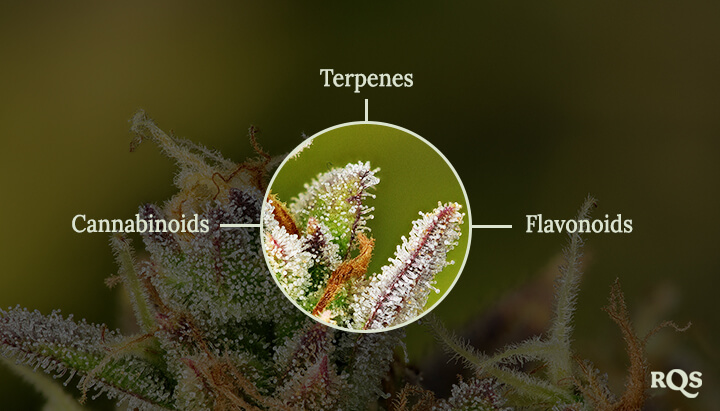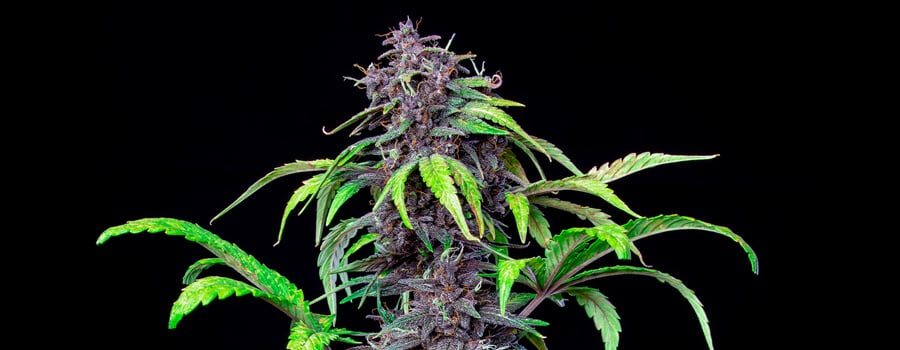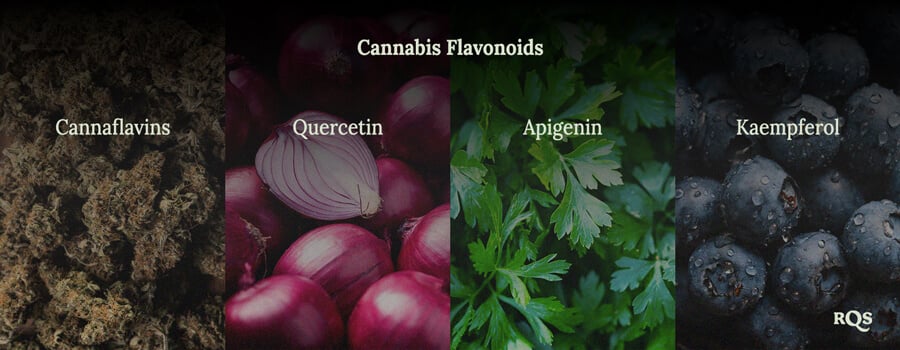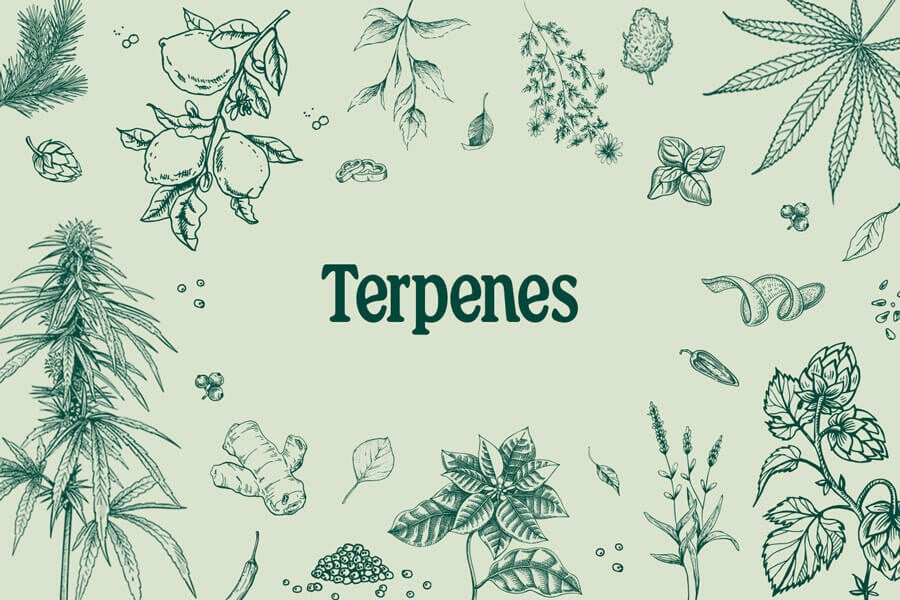.

Cannabis Flavonoids: A Comprehensive Guide
Flavonoids aren't so well-known, but they are still a relevant part of cannabis' chemical makeup, affecting the colour of the cannabis plant and potentially altering the high it produces. Here we take a look at flavonoids, their wellness potential, and their impact on the effects of cannabis.
In the realm of cannabis compounds, cannabinoids and terpenes steal most of the spotlight—but there's a third type of compound that is just as exciting: flavonoids. These little-known components are now gaining more attention in the cannabis world, and for good reason. Not only do they serve functions in the plant's biology, but they also offer a plethora of potential benefits we're only just beginning to understand.
In this article, we explore flavonoids, asking what effect they have on the cannabis experience, and their wellness potential too.
Contents:
Welcome to the World of Flavonoids
You may not be familiar with the term flavonoids, but they’re all around us. Present in many plants, they are not unique to cannabis—although some are. These compounds are produced throughout the plant’s anatomy, but are present in high concentrations in the trichomes, much like cannabinoids and terpenes. Though their influence on the effects of cannabis is not well understood, it is thought that they may have some impact, but more on this later.


-
Defining Flavonoids
At their core, flavonoids are chemical compounds that give plants their colors, protect them from biotic and abiotic stress, and perform an array of other vital functions. They’re produced right in the thick of cannabis’ complex biochemistry, serving various purposes, many of which are not really understood.
-
The Role of Flavonoids in Plant Biology
These compounds are the plant world's multitaskers. Not only do they contribute to the process of photosynthesis, but they also protect plants from harmful UV rays, fend off hungry insects, and even facilitate communication between plants. It's a fascinating system of defense and signalling.
Ever wondered why some cannabis plants can turn purple, pink, red, or even blue? Well, it’s because of flavonoids—in this case, anthocyanins. These compounds produce pigments in response to temperature fluctuations and thereby change the appearance of cannabis plants that contain them.


Therapeutic Potential of Flavonoids
Flavonoids are much more than nature's color palette. Recent studies suggest they could have some potential wellness benefits, though research on the matter is far from conclusive. And before we go any further, we’ll point out that even if flavonoids do have holistic benefits in certain instances, you shouldn’t assume that you could reap these from hitting a bong. Combustion is the killer of most good things.
From cell growth to ageing, the research on flavonoids is as promising as it is diverse. Let's explore some of the most exciting findings.
-
Cancer Research
Research has been conducted to determine the effects of flavonoids on the growth of tumour cells and cancer cell apoptosis. One study in particular focuses on the antioxidant properties of certain flavonoids in the realm of cancer research[1].
-
Inflammation Research
Chronic inflammation is a root cause of many diseases, from heart disease to diabetes. Studies have shown that flavonoids, particularly apigenin[2], may significantly reduce markers of inflammation in the body. Their natural origin and low potential for side effects make them an intriguing candidate for further research.
-
Depression Research
A survey conducted between 2007[3] and 2010 found that individuals who had a diet containing a high level of flavonoids were less likely to have depression than individuals who consumed fewer flavonoids.
However, flavonoids tend to be found in higher concentrations in healthier foods, which are known to generally have a positive effect on people’s moods. So isolating flavonoids as a causal factor could well be an oversimplification. However, it could be fair to assume that a diet rich in flavonoid-containing foods might be more conducive to a better mood.
-
Anti-Ageing Research
Ageing is a complex process influenced by many factors, including oxidative stress and inflammation. Flavonoids, with their antioxidant properties, are being studied for their potential to slow down markers of ageing and improve longevity.
One review observed that flavonoids[4] can influence the ageing process by eliminating senescent cells, inhibiting senescence-related secretion phenotypes (SASPs), and maintaining metabolic homeostasis. However, the study authors are also cautious to note that not enough research has been conducted and that more should take place before we can make any claims about flavonoids and the ageing process. Still, expect to see face creams boasting high concentrations of flavonoids sometime soon!
A Detailed Look at Cannabis Flavonoids
Cannabis is not just about THC and CBD, nor the terpenes responsible for the rich aromas and flavors it produces. The plant is also a rich source of flavonoids, including some unique to cannabis—known as cannflavins.
Below, starting with the unique cannflavins, we’ll look at some of the more common and better-understood flavonoids found in cannabis plants.


-
Cannflavins
Cannflavins are a group of phenolic compounds unique to cannabis, and you can find cannflavin A, B, and C in cannabis plants. Research suggests that cannflavins can have strong effects on the immune system, making them a promising candidate for future clinical research.
These are technically prenylflavonoids, which are found throughout the plant world, many of which have been noted to have some degree of antioxidant properties. These compounds are also considered adaptogens by those in the herbalist community.
-
Quercetin
Quercetin is a well-known flavonoid found in many plants, including cannabis. Its wellness benefits are potentially wide-ranging, and a fair amount of research has been conducted on this flavonoid.
This compound is a plant flavonol from the flavonoid group of polyphenols and is found in fruits, vegetables, seeds, grains, and more. It is featured as an additive in many foods and drinks, thanks to its bitter flavor. Though it is thought to have some wellness potential, quercetin is not FDA-approved.
-
Apigenin
Apigenin, mentioned earlier, is another flavonoid present in cannabis. When solid, it has a yellow crystalline form and is used as a dye for textiles. Once inside the body, it is known to bind to GABA receptors. There are conflicting findings around the effects that this has, and therefore it is too soon to draw conclusions from this interesting piece of knowledge. However, as this makes it pharmacologically active, it is likely that this compound in some way influences the “entourage effect” theory of cannabis chemical synergy.
-
Kaempferol
Named after the 17th-century German naturalist Engelbert Kaempfer, kaempferol is a flavonoid that may affect inflammation, and is found in cannabis as well as other plants such as kale, beans, tea, spinach, and broccoli. This flavonoid is not as widely researched as some others, so it is hard to say how it interacts with the body, let alone what effect it may have, if any, on the cannabis high.
Cannabis Microgreens: An Abundant Source of Flavonoids
When we think of superfoods, hemp microgreens might not be the first thing that comes to mind. But perhaps they will be now! These young cannabis plants are packed with flavonoids, offering nutritional benefits that surpass many other microgreens and vegetables. Hemp microgreens have a very high nutrient density, including a rich flavonoid content.
In fact, hemp microgreens are likely a much better source of flavonoids than smoked or vaped cannabis flower. Our bodies are primed to receive flavonoids through the stomach as part of our diet, not through the lungs via inhalation. As you don’t need THC-producing plants to grow hemp sprouts, you can buy yourself some cheap hemp seeds and grow these microgreens at home. Not only will it be healthy, but you won’t even be breaking the law!


Do Flavonoids Affect the Cannabis High?
While research is still catching up, there's speculation that flavonoids might influence the cannabis experience, contributing to the entourage effect and subtly affecting the nuances of each strain. There is some speculation that their impact on extracts and concentrates could be a game-changer, offering more customisation for cannabis products.
That being said, at this point, we just don’t know what each flavonoid does by itself, let alone how it works in concert with a number of other psychoactive compounds. So while it may well be possible that flavonoids do affect the high, you shouldn’t start picking your strains based on flavonoid ratios quite yet!
The Future of Weed Flavonoids
With the potential for new discoveries and applications, the future looks bright for these colorful compounds. At present, what we don’t know about flavonoids outweighs what we do know, and there’s quite some way to go before this changes. How flavonoids influence the effects of cannabis, as well as their potential wellness benefits, are still up in the air. Still, it’s exciting to learn more about our favorite plant, and in the meantime, we can enjoy ourselves by growing some cannabis microgreens and adding them to a delicious salad.
Keep an eye out—flavonoids might soon become as familiar a term as cannabinoids and terpenes in the cannabis lexicon.









































